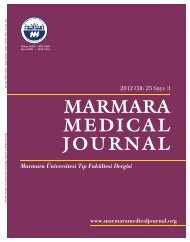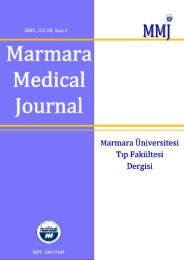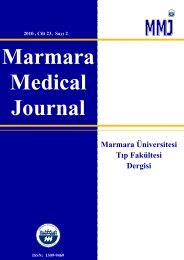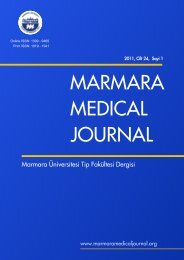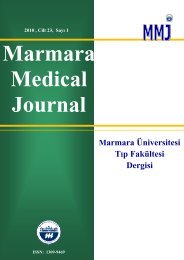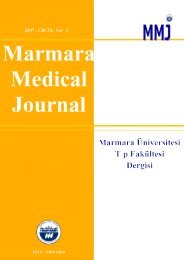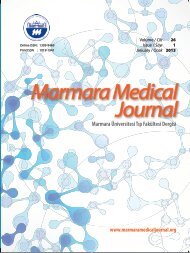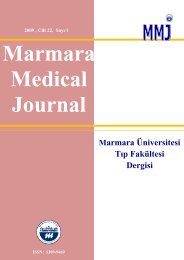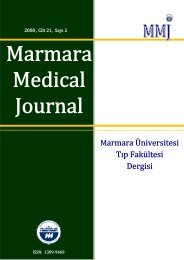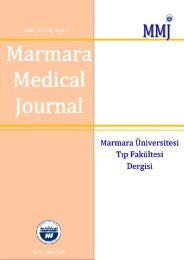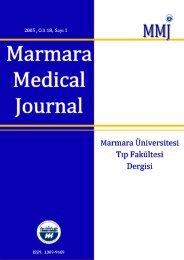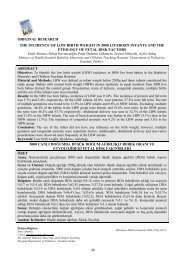Tam Metin PDF (4158 KB) - Marmara Medical Journal
Tam Metin PDF (4158 KB) - Marmara Medical Journal
Tam Metin PDF (4158 KB) - Marmara Medical Journal
- No tags were found...
You also want an ePaper? Increase the reach of your titles
YUMPU automatically turns print PDFs into web optimized ePapers that Google loves.
İ. TİNAY, et alRadical retropubic prostatectomyPostoperative follow-up evaluation includedserum PSA measurements every 3 months in thefirst year, every 6 months until the 5th year andyearly thereafter. Yearly digital rectal examinationand urinary sonography were performed. Cancerprogression was defined as detectable serum PSA(greater than 0.2 ng/ml), as documented byrepeated PSA measurements, local recurrence ordistant metastases.RESULTSMean age and preoperative PSA levelsThe mean age of this cohort of patientswas 63 years (range 44 to 75). The meanpreoperative PSA level was 9.38±1.14 ng/ml (range1.01 to 34.5). Of the patients 11.2 % had normalPSA levels (less than 4 ng/ml) and the majority hadlevels in the 4 to 10 ng/ml range.Preoperative tumor stage and GleasongradeAll tumors were clinically confined to theprostate gland. A total of 152 cases (60.8 %) werestage Tlc, which was the most prevalent clinicalstage. Thirty-four (13.6 %) were clinical stage T2a,21 (8.4 %) were clinical stage T2b and 36 (14.4 %)were clinical stage T2c. There were 2 patients withstage 1a and 5 patients with stage 1b disease.Preoperative Gleason scores 2 to 4 wereseen in 25 patients (10 %). A total of 151 patients(60.4 %) had moderately well-differentiated tumorswith Gleason scores of 5 and 6. Gleason score of 7was seen in 54 patients (21.6 %), distributed as(3+4) in 44 and (4+3) in 10 patients, respectively.Gleason score 8 to 10 ranges were seen in 20 (8 %)patients.Operative measuresMean operative time was 139±13 minutes(min: 100 min - max: 190 min) and mean blood losswas 880±116 ml (min: 300 ml - max: 2200 ml).Pathological findingsOf 250 cases, 173 (69.2%) demonstratedtumors confined within the prostate gland (T2a, 2band 2c) and 77 prostates (30.8%) had tumors witheither positive surgical margins, capsularpenetration, invasion of seminal vesicles or acombination of these features. Positive margins andestablished capsular penetration were seen in 46cases (18.4%). Of these cases 20 (8 %) had focalcapsular penetration with negative margins and 12(4.8 %) had positive surgical margins only. A total of32 cases (12.8 %) demonstrated seminal vesicleinvasion (pT3b) and only 8 patients (3.2%) hadpelvic lymph node metastases on final pathologicalexamination.Incontinence and erectile dysfunctionNerve-sparing RP patients were found tobe more successful in achieving continence. Meanincontinence scores at the 3rd and 12th months inthe nerve-sparing group was found to be 3.08 and1.97; whereas the same scores of non-nervesparinggroup were 4.27 and 3, respectively(p=0.042). With our new urethrovesical anastomosistechnique, our continence (defined as no or singleprotective pad) rate was 98 % at 12 months afterthe operation, where continence rate was 86 % withthe conventional technique.Preoperatively, only 22.9 % of the patientshad no erectile dysfunction. The meanpostoperative IIEF-5 scores of the nerve-sparing RPpatients pre-operatively and at the 1st, 3rd and 12thmonths were found to be 17.66 ± 5.61, 2.06 ± 1.73,4.1 ± 2.8 and 6 ± 4.45, respectively. The meanpostoperative IIEF-5 scores of the non-nervesparingRP patients pre-operatively and at 1, 3 and12 months were found to be 17.28 ± 5.3, 2.04 ± 1.9,3.24 ± 2.19 and 3.45 ± 2.54, respectively. In thenerve sparing group 11.9% of the patients had anIIEF score of 12 or higher in the post-operativeperiod whereas this result was not achieved in anyof the patients in the non-nerve sparing group.ComplicationsThere were no deaths related to surgery. Atotal of 8 patients (3.2 %) developed anastomoticstrictures which were treated successfully by asingle internal urethrotomy session without anyrecurrence. A total of 3 patients (1.2 %) developedlymphoceles, which were treated with percutanouscatheter drainage.Follow-up and oncological outcomeOf 250 men, 31 (12.4 %) experiencedcancer progression following RP at a mean followupof 53.8±7.3 months (range 5 to 112). Mean timeto progression was 20.7±2.1 months (range 1 to 92).Of 31 men with cancer progression 14 (45.2 %) hadreceived adjuvant radiotherapy and all patientssubsequently received hormonal therapy. Only 2patients died of non-urological causes, one due to acerebrovascular accident and the other due tometastatic colon carcinoma.DISCUSSIONThe incidence of PCa has increaseddramatically with the widespread use of serum PSAas a screening tool for prostate cancer and as aresult, more men are diagnosed with curabledisease at a younger age. Today, men also livelonger and a man 65 to 70 years old has a 50 %chance of living for another 15 years in the westerncountries 6 . As a result, an increasing number ofradical prostatectomies are being performed andfavorable outcomes are reported in the literature.Radical prostatectomy is the only form oftreatment for localized PCa that has been shown ina randomized controlled trial to reduce progressionto metastases and death from the disease 14 . It isalso the ideal treatment for patients who can becured and who will live long enough to benefit fromit. Based on high patient satisfaction rates, openradical retropubic prostatectomy is an excellenttreatment for prostate cancer 15 .A large quantity of long-term data hasconfirmed the efficacy of open radicalprostatectomy. In a large open prostatectomy serieswith a median follow-up of 5.3 years, the Johns12<strong>Marmara</strong> <strong>Medical</strong> <strong>Journal</strong> 2011; 24 (1):10-14



